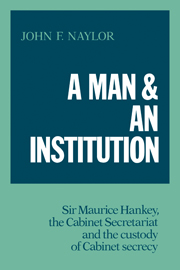 A Man and an Institution
A Man and an Institution Book contents
7 - The custody of Cabinet secrecy
Published online by Cambridge University Press: 30 March 2010
Summary
No informed account of the post-war Cabinet Secretariat can yet be written, although it is clear that Hankey's successors have not followed in all the footsteps of the man; it is as well apparent that there was a substantial measure of continuity between his operation of the Secretariat mechanism and that of his immediate successor, Sir Edward Bridges. Nor is there direct evidence of far-reaching organizational change since that time, although questions have been posed about the contemporary Cabinet Office which deserve mention in this account. And the question of the influence of the Cabinet Secretary upon the Prime Minister and the Cabinet will remain, but it is not a matter that even the release of Cabinet records in due time can answer fully. It is certain that whatever the degree of influence of Hankey's successors, none brought to bear anything approaching his suasion in defence matters.
All Cabinet Secretaries have agreed upon the need to protect the deliberations of the Cabinet from outside scrutiny, and each has administered and enforced Cabinet secrecy with whatever devices he judged efficacious. In Hankey's time, there was no certainty that Cabinet records would eventually pass into the public domain, but the Public Records Act of 1958 made it probable that they would be released, although the legislation did not specify that Cabinet papers would be made available.
- Type
- Chapter
- Information
- A Man and an InstitutionSir Maurice Hankey, the Cabinet Secretariat and the Custody of Cabinet Secrecy, pp. 266 - 318Publisher: Cambridge University PressPrint publication year: 1984


